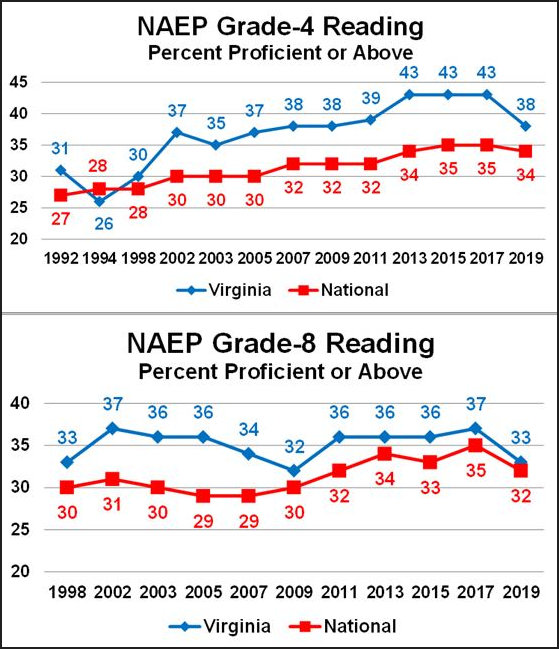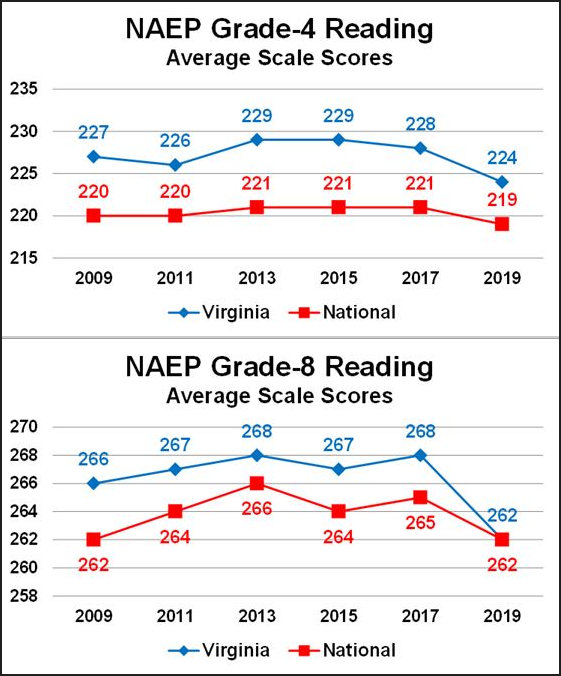Reading scores of Virginia students taking the National Assessment of Educational Progress (NAEP) tests, a national standardized test, plummeted this year, and math scores declined as well. The average reading scores of Virginia fourth- and eighth-grade students on the national tests fell by four and six points, respectively. The average math scores for percent proficient fell by two points for both grades.
In releasing the results, Superintendent of Public Instruction James Lane acknowledged that Virginia has a big problem. “The latest NAEP results — coupled with the declines we have seen during the last several years on our state reading tests — underscore the importance of the efforts already underway at the state and local levels to strengthen reading instruction for all students,” he said.
He implied that factors other than the Progressive “racial equity” policies he has championed are to blame. Rather, he said, “We must … recognize that Virginia’s schools are enrolling increasing numbers of students whose learning is impacted by poverty and trauma.”
The solution: $950 million in money for “equitable supports and services for all of the students who need them.”
The NAEP tests, based upon a representative sampling of approximately 4,600 4th graders and 4,300 8th graders, are used to compare the average educational performance of the 50 states and District of Columbia. Virginia students have traditionally scored above the national average, and they did so again in 2019. Virginia is one of 17 states that saw declines in performance in fourth-grade reading and one of 31 states that saw declines in eighth-grade reading.
 NAEP defines “proficiency” on the tests as “solid academic performance … over challenging subject matter.” By this measure, Virginia 4th-grade scores, which had been trending higher since 1992 before plateauing in 2013, also took a sharp dive, as can be seen in the graphs shown here.
NAEP defines “proficiency” on the tests as “solid academic performance … over challenging subject matter.” By this measure, Virginia 4th-grade scores, which had been trending higher since 1992 before plateauing in 2013, also took a sharp dive, as can be seen in the graphs shown here.
Earlier this month the state Board of Education proposed new public schools Standards of Quality (SOQs) that include increased funding for reading specialists and the creation of an “equity fund” that would provide an additional $131.9 million in state support for schools serving significant numbers of children in poverty. The fund would pay to recruit and retain experienced and effective teachers and other professional staff in high-poverty schools and provide additional intervention and remediation services for students.
Bacon’s bottom line: Declining NAEP scores over the past two years do little to inspire confidence in the Northam administration’s diagnosis of what ails Virginia’s educational system and how to improve it. But Lane has gamely used the failure as justification for entrusting the system with another $950 million in tax dollars.
Lane blames the “increasing numbers of students whose learning is impacted by poverty and trauma.” While it is true that Virginia public school students come disproportionately from economically disadvantaged backgrounds, Lane presented no evidence of a surge in the number of poor kids or “disabled” kids suffering from poverty-related trauma taking the NAEP exams between 2017 and 2019.
What is the data?
According to Virginia Department of Education data, the percentage of Virginia public school students classified as “disadvantaged” taking the English Standards of Learning exams did tick up slightly between the 2016-17 school year and 208-19: from 39.3% to 41.7% in continuation of a long-term trend. However, it is also true that if we focus just on disadvantaged students, the SOL English pass rate declined during that same period from 66.7% to 64.7%. In other words, the problem is bigger than the fact that there are more disadvantaged students.
Regarding poverty-related trauma, Lane was likely referring to the commonly accepted view that traumatic events in childhood can cause emotional disturbances later in life that affect behavior and learning. VDOE’s Special Education Child Count data set indicates that the number of children in Virginia public schools classified as “disabled” (which encompasses those with trauma-related disabilities as a sub-set) actually declined slightly over the 1o-year period between 2006 and 2016 (the most recent year for which published data is available): from 173,000 students to 169,000 students.
More recent data found in the VDOE’s “Test Results Build-a-Table” database suggest that the percentage of disabled students who took the English SOLs increased slightly, from 15.3% of the test-taking population in 2016-17 to 15.8% in 2018-19. I question, however, whether these modest changes explain the nose-dive in reading test scores. At the very least, the link between poverty/trauma and plunging test scores over a two-year period is less than self-evident.
I find it interesting that Lane did not take credit for one nugget of positive news in the otherwise dismal results: The gap in black-white NAEP scores shrank slightly between 2017 and 2019 — from 27 points to 24 points. Normally, that would be considered good news. A possible reason for omitting that positive datum: It would undercut the Northam administration’s case that the reading problem is concentrated in school districts with large populations of poor students and requires remedies focused on those districts.
Whatever the reasons for the sharp drop in scores, it is clear that Virginia’s educational system has taken a wrong turn. Virginians need to take a deep, data-driven look at what has gone wrong, and we need to be willing to revise or even abandon worn-out nostrums for what works and what doesn’t.


Leave a Reply
You must be logged in to post a comment.